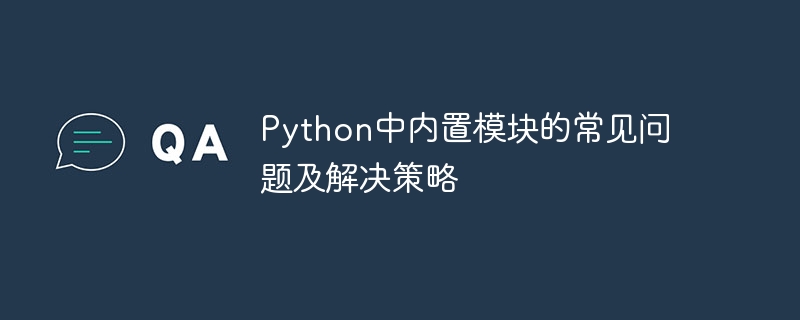

Common problems and solution strategies for built-in modules in Python
Introduction:
As a simple, easy-to-learn and powerful programming language, Python’s built-in modules provide many commonly used functions and tools. However, because of its widespread use, some common problems arise. This article will introduce some typical problems with Python's built-in modules and provide corresponding solution strategies and code examples.
1. Module: datetime
Question 1: How to convert a date and time string into a datetime object?
Solution strategy: Use the strptime() function to convert the string into a datetime object.
Sample code:
import datetime # 定义日期时间字符串 date_str = "2022-01-01 10:30:00" # 将字符串转换为datetime对象 date_obj = datetime.datetime.strptime(date_str, "%Y-%m-%d %H:%M:%S") print(date_obj) # 输出:2022-01-01 10:30:00
Question 2: How to get the current date and time?
Solution strategy: Use the now() function to get the current date and time.
Sample code:
import datetime # 获取当前日期时间 current_datetime = datetime.datetime.now() print(current_datetime) # 输出:当前日期时间
2. Module: random
Question 1: How to generate random integers?
Solution strategy: Use the randint() function to generate a random integer within the specified range.
Sample code:
import random # 生成1到100之间的随机整数 random_int = random.randint(1, 100) print(random_int) # 输出:随机整数
Question 2: How to randomly select elements from a list?
Solution strategy: Use the choice() function to randomly select an element from the given list.
Sample code:
import random # 定义列表 my_list = [1, 2, 3, 4, 5] # 从列表中随机选择一个元素 random_elem = random.choice(my_list) print(random_elem) # 输出:随机选择的元素
3. Module: re
Question 1: How to use regular expressions for string matching?
Solution strategy: Use the match() function to match from the beginning of the string, and use the search() function to match globally.
Sample code:
import re # 定义要匹配的字符串 text = "Hello, World!" # 使用match()函数从字符串开头匹配 match_obj = re.match(r"Hello", text) # 使用search()函数全局匹配 search_obj = re.search(r"World", text) print(match_obj) # 输出:匹配结果对象 print(search_obj) # 输出:匹配结果对象
Question 2: How to replace part of the content in the string?
Solution strategy: Use the sub() function to replace.
Sample code:
import re # 定义要替换的字符串 text = "Hello, World!" # 使用sub()函数替换 new_text = re.sub(r"World", "Python", text) print(new_text) # 输出:Hello, Python!
Summary:
This article introduces several common built-in modules in Python and provides corresponding problems and solution strategies. By learning and mastering the features and usage of these modules, you can better apply Python for development and programming. Of course, these are just some simple examples. In actual use, they need to be flexibly adjusted and applied according to specific needs. I hope this article can be of some help and guidance to readers.
The above is the detailed content of Common problems and solution strategies for built-in modules in Python. For more information, please follow other related articles on the PHP Chinese website!




